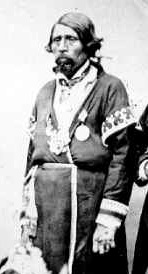

Jacques-Pierre Peminuit Paul was a Grand Chief of the Mi'kmaq who lived at Shubenacadie, Nova Scotia. He was most well known for his shamanic abilities. [1] [2]
Contents
On 15 September 1856, Paul was confirmed as grand chief by Archbishop William Walsh at St. Mary's Basilica (Halifax), receiving a medal from Pope Pius IX and a written endorsement from the Lt. Governor, Sir John Gaspard Le Marchant. [3]
In 1879, Paul met with the Governor General of Canada, the Marquess of Lorne, in the Red Chamber, Province House, Halifax, Nova Scotia.